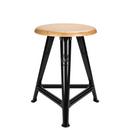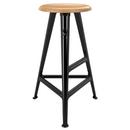Rowac
Not found what you were looking for?
We can deliver all products from this manufacturer. Please contact us at +49 341 22228822
or service@smow.com to discuss your specific product request.

Rowac - The "Bauhaus-Schemel" is given a new lease of life
From the end of the 19th century to the second half of the 20th century Rowac stood for ergonomic furniture made of sheet steel; an innovative manufacturer whose products were primarily used in factories and workshops, including the Bauhaus workshops. The company's most famous product is the Rowac stool - also known as the Rowac-Schemel or Bauhaus stool - a work once again being produced, and that in its place of origin.
The story behind the Rowac-Schemel
The history of the Rowac-Schemel goes back to the late 19th century. In the heyday of industrialisation Karl Robert Wagner founded an ironware factory in Chemnitz, which he named Rowac based on his name and lcation: RObert WAgner Chemnitz. In 1909 Wagner developed the "Model 1", the world's first riveted seating object crafted from lightweight sheet steel. In contrast to solid metal legs Wagner was able to save material without sacrificing stability by using sheet steel that was punched into a slightly square U-profile. In this way, he created a sturdy, durable stool that was both visually and physically light with a minimum of material. This innovative design gave rise to a whole range of ergonomically shaped furniture for workshops and offices, including chairs, tables, tool boxes and cabinets.
The stool became one of Rowac's most successful products and was also used in the Bauhaus in Weimar, Dessau and Berlin. The company also survived the Second World War, but had to concentrate on wood processing because of the ban on steel furniture production. After the war production was stopped under Soviet occupation, but Rowac furniture continued to be used in the DDR. When the DDR factories were closed or modernized after the fall of the Berlin Wall, much of the robust Rowac furniture was discarded.
Re-edition of the Rowac-Schemel
In 2023 Alide and Dieter Amick, master optician and industrial designer respectively, decided to revive the historic furniture brand Rowac: and that in its place of origin, Chemnitz. They sought to reconstruct the furniture true to the original based on the designs of Karl Robert Wagner. The re-editions began with the legendary Rowac stool in two formats: the Rowac stool model I with a height of 50 cm and the Rowac stool model I in bar stool version (75 cm). Other Rowac models followed and further re-editions are planned. You can read more about Rowac in the smow Blog interview with Alide and Dieter Amick.

Karl Robert Wagner - inventor and eponym of the Rowac stool

Alide und Dieter Amick - company re-founders and producers of the Rowac re-editions
The Rowac-Schemel - a practical, sustainable and timeless stool design
Today Rowac combines many of the things that Alide and Dieter Amick are passionate about, including classic, timeless design with a clear design language and objects with a history that embody craftsmanship. With the Rowac re-editions Alide and Dieter Amick want to offer furniture that is practical, indestructible and honest.
The Rowac stools are practical as they can be used in a variety of ways as light and elegant seating or side tables. Indestructible as they are manufactured to a quality that is maintained over decades. And honest because they do not hide anything: just as every connection, whether riveted or jointed, remains visible, Alide and Dieter Amick also guarantee a transparent and sustainable use of materials and production processes. The Rowac stools are manufactured in the Chemnitz region, where they originated, in collaboration with local craft businesses.

Bauhäusler on Rowac stools - Weimar, 1923


























